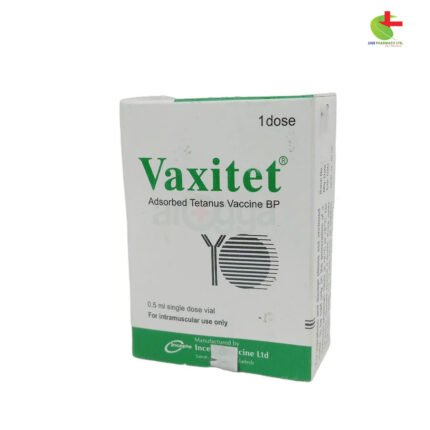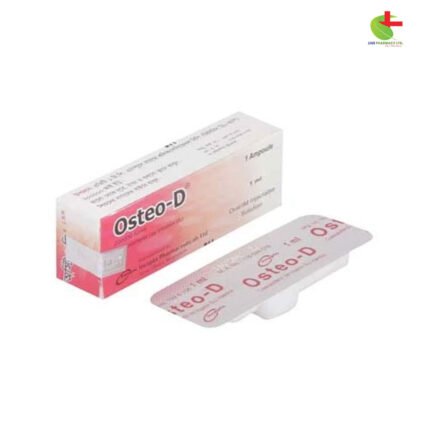Kilbac Vial
125.00৳ Injection (750mg)
- Kilbac IM/IV Injection contains Cefuroxime Axetil, a potent antibacterial agent designed for the treatment of infections caused by sensitive bacteria.
- Each vial contains 750 mg of the active ingredient, ensuring effective dosing for various bacterial infections.
- It is indicated for treating conditions such as pharyngitis, sinusitis, pneumonia, and skin infections, among others.
- Kilbac showcases good stability against β-lactamase, making it suitable for resistant strains.
- Available in tablet and injectable forms, it provides flexible dosing options for both adults and children.
 Brand
Brand
|
Incepta Pharmaceuticals Ltd |
|---|---|
 Generics
Generics
|
Cefuroxime Axetil |
 Type
Type
|
IM/IV Injection |
Indications
This medication is indicated for the treatment of infections caused by susceptible bacteria, including:
- Pharyngitis/Tonsillitis: Resulting from Streptococcus pyogenes.
- Acute Bacterial Otitis Media: Due to Streptococcus pneumoniae, Haemophilus influenzae, Moraxella catarrhalis (including beta-lactamase producing strains), or Streptococcus pyogenes.
- Acute Bacterial Maxillary Sinusitis: Caused by Streptococcus pneumoniae or non beta-lactamase producing strains of Haemophilus influenzae.
- Lower Respiratory Tract Infections: Including pneumonia, due to Streptococcus pneumoniae, Haemophilus influenzae (including beta-lactamase producing strains), Klebsiella spp., Staphylococcus aureus (both penicillinase and non-penicillinase producing strains), Streptococcus pyogenes, and E. coli.
- Acute Bacterial Exacerbation of Chronic Bronchitis: As well as secondary bacterial infections of acute bronchitis caused by Streptococcus pneumoniae, non beta-lactamase producing strains of Haemophilus influenzae, or Haemophilus parainfluenzae (beta-lactamase negative).
- Skin and Skin Structure Infections: Resulting from Staphylococcus aureus (including beta-lactamase producing strains) or Streptococcus pyogenes.
- Urinary Tract Infections: Caused by E. coli or Klebsiella pneumoniae.
- Bone and Joint Infections: Due to Staphylococcus aureus (both penicillinase and non-penicillinase producing strains).
- Gonorrhea: From both penicillinase and non-penicillinase producing strains of Neisseria gonorrhoeae.
- Early Lyme Disease: Specifically erythema migrans, caused by Borrelia burgdorferi.
Note: Always follow the advice of a registered healthcare professional when taking this medication.
Pharmacology
Cefuroxime is a highly effective and well-characterized antibacterial agent that exhibits broad-spectrum bactericidal activity against a variety of common pathogens, including those that produce β-lactamase. This medication demonstrates excellent stability against bacterial β-lactamase, making it effective against many strains resistant to ampicillin and amoxicillin.
Dosage
Tablet or Suspension:
Adolescents and Adults (13 years and older):
- Pharyngitis/Tonsillitis: 250 mg twice daily for 5-10 days
- Acute Bacterial Maxillary Sinusitis: 250 mg twice daily for 10 days
- Acute Bacterial Exacerbation of Chronic Bronchitis: 250-500 mg twice daily for 10 days
- Secondary Bacterial Infections of Acute Bronchitis: 250-500 mg twice daily for 5-10 days
- Uncomplicated Skin and Skin Structure Infections: 250-500 mg twice daily for 10 days
- Uncomplicated Urinary Tract Infections: 250 mg twice daily for 7-10 days
- Uncomplicated Gonorrhea: 1000 mg as a single dose
- Community-Acquired Pneumonia: 250-500 mg twice daily for 5-10 days
- MDR Typhoid Fever: 500 mg twice daily for 10-14 days
- Early Lyme Disease: 500 mg twice daily for 20 days
Pediatric Patients (3 months to 12 years):
- Pharyngitis/Tonsillitis: 20 mg/kg/day twice daily for 5-10 days
- Acute Otitis Media: 30 mg/kg/day twice daily for 10 days
- Acute Bacterial Maxillary Sinusitis: 30 mg/kg/day twice daily for 10 days
- Impetigo: 30 mg/kg/day twice daily for 10 days
Parenteral Administration:
- Adults: 750 mg administered three times daily via IM or IV injection. In cases of severe infection, the dose can be increased to 1.5 g three times daily. Frequency may be increased to four times daily if necessary, with total daily doses ranging from 3 to 6 g.
- Children (over 3 months): 30-100 mg/kg/day in 3 or 4 divided doses; a dose of 60 mg/kg/day is generally adequate for most infections.
- Neonates: 30-100 mg/kg/day divided into 2 or 3 doses.
- Surgical Prophylaxis: 1.5 g IV at the induction of anesthesia; up to 3 additional doses of 750 mg may be given every 8 hours for high-risk procedures.
- Pneumonia: 1.5 g IV twice daily for 2-3 days, then 500 mg orally twice daily for 7-10 days.
- Acute Exacerbations of Chronic Bronchitis: 750 mg twice daily (IM or IV) for 2-3 days, followed by 500 mg twice daily orally for 5-10 days. (Duration of both parenteral and oral therapy depends on the severity of the infection and the clinical status of the patient.)
- Gonorrhea: 1.5 g as a single dose (administered as 2 x 750 mg injections intramuscularly at different sites, e.g., each buttock).
In Meningitis:
- Adults: 3 g IV three times daily.
- Children (over 3 months): 200-240 mg/kg/day IV in 3 or 4 divided doses, reduced to 100 mg/kg/day after 3 days or upon clinical improvement.
- Neonates: Initial dose of 100 mg/kg/day IV, then reduced to 50 mg/kg/day when clinically indicated.
For Bone and Joint Infections:
- Adults: 1.5 g IV four times daily.
- Children (over 3 months): 150 mg/kg/day (not exceeding the maximum adult dose), divided every 8 hours.
Note: Always follow the advice of a registered healthcare professional when taking this medication.
Administration
It is recommended to use a freshly reconstituted solution. However, if stored properly, the solution retains its potency for at least 24 hours at room temperature or 48 hours at 5°C.
Note: Always follow the advice of a registered healthcare professional when taking this medication.
Interaction
Currently, there are no known hazardous interactions reported.
Contraindications
Cefuroxime should not be used in patients with a known allergy to cephalosporins.
Side Effects
Adverse reactions to Kilbac are infrequent and generally mild, often transient. Reported side effects include rashes and gastrointestinal disturbances. As with other antibiotics, prolonged use may lead to the overgrowth of non-susceptible organisms, such as Candida.
Pregnancy & Lactation
Cefuroxime falls under US FDA pregnancy category B. While there are no adequate and well-controlled studies in pregnant women, this medication should only be used during pregnancy when clearly necessary. It has been shown to be excreted in human milk; therefore, caution is advised when administering Cefuroxime to nursing mothers.
Precautions & Warnings
Kilbac should be administered with caution to patients receiving potent diuretics and those with a history of colitis. Generally, cephalosporin antibiotics can be safely administered to patients with a hypersensitivity to penicillin, although cross-reactions have been reported. At the recommended dosage levels, Kilbac is unlikely to pose a problem.
Therapeutic Class
Second Generation Cephalosporins
Reconstitution
For 750 mg intramuscular injection: Add 3 ml of water for injection to the vial and gently shake for dispersion.
For 750 mg intravenous injection: Add 8 ml of water for injection to the vial and gently shake for dispersion. The solution should be injected slowly into a vein over 3 to 5 minutes.
For 1.5 g intravenous injection: Add 16 ml of water for injection to the vial and gently shake for dispersion. The solution should be injected slowly into a vein over 3 to 5 minutes.
Storage Conditions
Store in a cool, dry place (below 30°C), protected from light and moisture. Keep out of reach of children.













Reviews
There are no reviews yet.